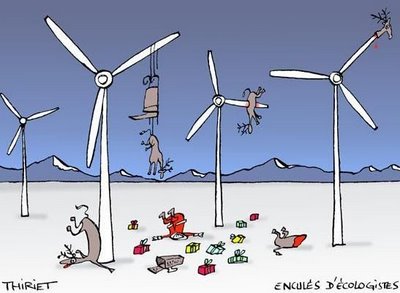Naples Appeals to PSC
 Naples: Don’t get too close with those windmills
Naples: Don’t get too close with those windmills
By Emily McFaul, correspondent
Naples, NY — The Town Board says wind turbines planned for neighboring Prattsburgh come too close to the Naples town line. Board members agreed this month to send a letter asking the state Public Service Commission to intervene and order a developer to move the towers further from town line.
“I think the board has made clear, we’re not against wind turbines, but we are against the improper siting of towers,” Supervisor Frank Duserick said.
This is not the first letter of protest the town has issued regarding the location of towers in neighboring townships. In July, the town appealed to the state Attorney General’s Office, arguing that Naples landowners’ property rights and safety are threatened by the placement of the towers. While a date has yet to be set, the Attorney General’s Office has expressed interest in meeting with the town.
At issue are turbines planned for Knapp Hill in Prattsburgh, part of the Ecogen project. Five turbines are scheduled to go up in the area, with the closest only 489 feet from Naples landowner John Servo’s property line. Servo is president of the group Advocates for Prattsburgh, which has opposed this project.
Technically, the setbacks meet project guidelines established for Ecogen through an environmental study headed up by the Steuben County Industrial Development Agency. But both Servo and the Naples Town Board say the setbacks are not enough.
The neighboring town of Cohocton passed a zoning law prohibiting the placement of turbines closer than 1,500 feet from a residence, a step that Duserick points out to the PSC as precedent that another town has acknowledged the undesirability of building within that range.
By placing turbines less than 500 feet from the Naples property line, Duserick and Servo argue that the project is creating “reverse zoning” that effectively limits Naples landowners from full use of their property for safety reasons. “The safety zone is 1,500 feet,” Duserick later said. “There should be a 1,500 feet setback, and actually it’s not enough. That’s for the smaller turbines.”
At a hearing last month, the Steuben County IDA outlined Ecogen’s new plans to install larger 2.3-megawatt turbines instead of the originally planned 1.5-megawatt model, but Naples received no advance notice of the hearing.
The increase in the turbine size means that only 36 towers will be placed instead of the 53 originally planned, but the towers will be 26 feet taller to generate the increased output. Ecogen project manager Thomas Hagner said contrary to what some project critics have suggested, no new environmental study is required.
And despite the number of towers being scaled back, with the site earmarked a prime wind resource, the Knapp Hill towers are still planned. Technically, Ecogen is within its rights to do so, said Hagner. “The turbines meet the permitting requirements of the government agency with jurisdiction on this issue,” he said.
For Duserick, frustration goes back to initial planning phases for the wind project, when the IDA notified the village but not the town of the impending development, leaving the town out of the loop in the environmental review process.
“It’s inappropriate and unethical to place towers so close to the town line without even talking to (us),” said Duserick. “I clearly question the ethics of what’s happening in Steuben County.”
In the letter to the PSC, the town also asks for setbacks of five miles from designated historic sites in Naples like the Memorial Town Hall, in order to protect the town’s scenic views and tourism trade.
The environmental review process for wind developments evaluates the visual impacts of turbines for a radius of 5 miles; for the Ecogen project, the determination recorded in the environmental impact statement is that there would not be “significant adverse impact for distant views (greater than approximately 2 miles).”
But there is some precedent in the PSC limiting turbines from being built in sites where they could be visually and economically detrimental. Last year, the PSC required Jordanville Wind to eliminate 19 of the 68 turbines planned for its Herkimer County project, since they would be visible from the Glimmerglass Historic District. Though the district fell outside of the 5-mile radius, the PSC acknowledged the district as a “nationally significant” historic resource, and a key factor in a regional economic plan developed around heritage-based tourism.
Labels: Cohocton, Legal Issues, Process





